
Abandoned & Little-Known Airfields:
Texas, Amarillo area
© 2002, © 2015 by Paul Freeman. Revised 9/19/15.
This site covers airfields in all 50 states: Click here for the site's main menu.
____________________________________________________
Please consider a financial contribution to support the continued growth & operation of this site.
(Original) Amarillo Municipal Airport (revised 7/18/15) - Dalhart Aux AAF #1 (revised 7/18/15)
Dalhart Aux AAF #2 / Miller Field (revised 7/18/15) - KFDA-TV Airfield (revised 2/1/15)
Pampa AAF (revised 4/10/14) - Reeves Aux AAF #1 / Pampa Air Force Aux Airfield #2 (revised 4/10/14) - Twitty Intermediate Field (added 9/19/15)
____________________________________________________
Twitty Intermediate Field, Twitty, TX
35.3, -100.22 (East of Amarillo, TX)

A 7/13/43 aerial view looking north at Twitty Intermediate Field, from the July 1944 AAF Airfield Directory (courtesy of Rhonda Weriwether).
This airfield was evidently one of the network of Intermediate Fields constructed in the 1930s by the Commerce Department
for the emergency use of commercial aircraft along airways between major cities.
The date of establishment of Twitty Intermediate Field has not been located.
The earliest depiction which has been located of Twitty Intermediate Field
was a 7/13/43 aerial view from the July 1944 AAF Airfield Directory (courtesy of Rhonda Weriwether).
It depicted Twitty Intermediate Field as having several unpaved runways.
The July 1944 AAF Airfield Directory (courtesy of Rhonda Weriwether)
described Twitty Intermediate Field as a 146 acre irregularly-shaped property
having 4 sod runways, with the longest being the 3,766' northwest/southeast runway.
The field was said to not have any hangars, to be owned by private interests,
and operated by the Civil Aeronautics Administration.
The 1945 AAF Airfield Directory (courtesy of Scott Murdock)
described Twitty Intermediate Field in the same fashion.

The only aeronautical chart depiction which has been located of Twitty Intermediate Field
was on the 1945 OK City Sectional Chart, which depicted Twitty as a commercial/municipal airport,
and labeled it as Site 8A along the airway.
Twitty Intermediate Field was evidently abandoned at some point between 1945-54,
as it was no longer depicted on the 1954 USGS topo map.
Most of the Intermediate Fields in rural areas were abandoned as advances in the range & reliability of commercial aircraft made the Intermediate Fields unnecessary.

Amazing a 1996 aerial view of the site of Twitty Intermediate Field showed that the diagonal runway alignment of several runways
was still recognizable more than 50 years after the airport was abandoned.

A 2014 aerial view shows a circular irrigation plot was built over the site of Twitty Intermediate Field,
but traces of the diagonal runway alignment was still recognizable on the south end of the airfield site.
The site of Twitty Intermediate Field is located southeast of the intersection of Route 83 & Route 592.
Thanks to Rhonda Meriwether for pointing out this airfield.
____________________________________________________
KFDA-TV Airfield, Amarillo, TX
35.29, -101.84 (North of Downtown Amarillo, TX)

The KFDA-TV airfield, as depicted on the March 1962 Oklahoma City Sectional Chart (courtesy of David Brooks).
Photo of the airfield while open has not been located.
The KFDA Airfield was not yet depicted on the 1949 OK City Sectional Chart (courtesy of John Price).
According to John Fullingim, “The KFDA strip was established by a KFDA weather man in the 1950s.
His name was Dan True & he was a local celebrity.
He had a Piper Cub & lived down near Palo Duro Canyon & flew to work many days.
I worked with him at KGNC. He often talked about his flying on the air & was quite a character.”
The KFDA-TV Airfield was not yet depicted on the 1961 Oklahoma City Sectional Chart (according to David Brooks).
The earliest depiction of the KFDA-TV Airfield which has been located
was on the March 1962 Oklahoma City Sectional Chart (courtesy of David Brooks).
It depicted KFDA-TV as a private airfield having a 1,500' unpaved runway.
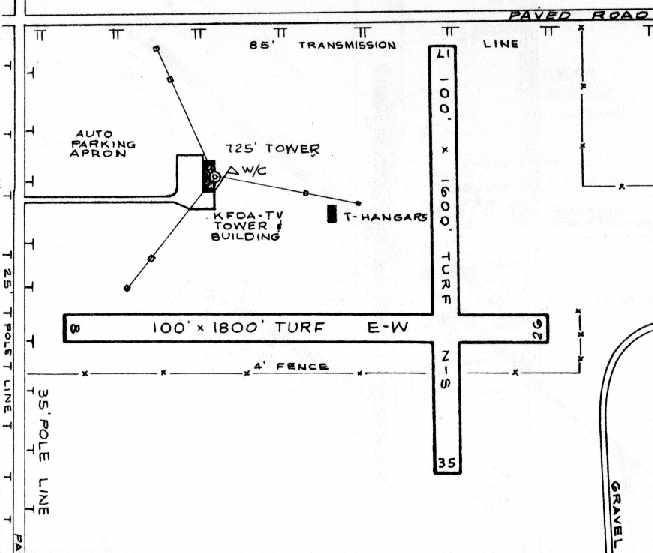
The 1966 TX Airport Directory (courtesy of David Brooks) depicted the KFDA-TV Airfield
as having 2 turf runways: 1,800 Runway 8/26 & 1,600 Runway 17/35.
The runways were located immediately adjacent to the southeast of the tower & supporting wires of the television transmitter,
which must have made approached to the runways quite interesting.
A single building of T-hangars was located northwest of the runway intersection.
The operator was listed as Dan True [who was also the weatherman at KFDA-TV].
The 1966 AOPA Airport Directory (according to David Brooks) described the KFDA-TV Airfield
as having 3 runways, all turf/sod, with the longest being the 1,500' Runway 9/27.
The operator was listed as Dan True,
and warnings were included for high towers & electrical power lines around the edges of the airfield.
No hangar facilities were described - just tie-downs.
A 1967 aerial photo showed an open grass field, without any recognizable runways,
with the single T-hangar building on the northwest side.
USGS topo maps from the 1960s, 1970s, and 1980s did not depict an airfield of any kind.

The February 1970 DFW Sectional Chart (courtesy of David Brooks)
depicted the KFDA-TV airfield as having a 1,700' unpaved runway.
The last chart depiction of KFDA-TV as an active airfield which has been located
was on the 1972 DFW Sectional Chart (according to David Brooks).
According to John Fullingim, “The gigantic transmission towers were built in the early 1970s,
and were not there when Dan was at KFDA.
I have been to the KFDA site many times.”
The KFDA-TV Airfield was evidently closed at some point between 1972-78,
as it was no longer depicted on the 1978 DFW Sectional Chart (according to David Brooks).
The 1995 USGS aerial photo showed that a new transmitter tower had been built somewhat to the east of the old one,
roughly over the northern portion of the former airfield.

In a 2014 aerial photo, traces of the 2 former KFDA Airfield runways were still apparent.
No airfield buildings appeared to remain.
The site of the KFDA-TV Airfield is located southeast of the intersection of West Cherry Avenue & Broadway Road.
____________________________________________________
(Original) Amarillo Municipal Airport, Amarillo, TX
35.23, -101.78 (Northeast of Downtown Amarillo, TX)

A 10/13/43 aerial view looking north at Amarillo Municipal Airport
from the 1945 AAF Airfield Directory (courtesy of Scott Murdock).
The town of Amarillo had a short-lived municipal airport located 6 miles northeast of the center of the town.
The Amarillo Municipal Airport was evidently established at some point between 1940-43,
as it was not yet depicted on the July 1940 Albuquerque Sectional Chart.
The earliest depiction of the Amarillo Municipal Airport which has been located
was a 10/13/43 aerial view from the 1945 AAF Airfield Directory (courtesy of Scott Murdock).
It depicted the field as consisting of a square unpaved landing area.
According to Jim Foreman, “The big hangar in the photo was to house the planes of TAT & Trans Western on their overnight stops there.
Providing the hangar space free of charge was the way to get them to move their overnight stop
from Portales, NM where they were being charged for each night they were there.
When the officials at Amarillo heard that Lindbergh & his entourage would land there for fuel,
they organized an official dedication during which they would name it Lindbergh Field.
They built a stage for the event & even had the high school marching band there to play for the event.
When Lindbergh landed, he went to the bathroom & right back to his ship without stopping,
then he & all the rest of the airplanes in his flight left without paying for their fuel.
They painted over the name and changed it to Amarillo Municipal Airport.
When I soloed there in 1944, you could still see 'Lindbergh Field' through the white paint covering it.”
Jim continued, “Harold English, who was operating his flight school from a runway on the east side of Fillmore Street & north of the railroad tacks,
applied for the position of Airport Manager but the mayor blocked it saying he would never hire a drunk to manage the city airport.
That was what prompted English, backed by his brother-in-law, Thornton Oxnard (playboy son of Henry Oxnard who founded Oxnard, CA)
to buy a section of land 5 miles east of Amarillo Municipal to build his own airport
and through a stock deal with the 2 airlines, got them to move their operation to the new English Field.”
Jim continued, “Bob Siler was manager of Amarillo Municipal airport when I soloed there on my 16th birthday, 11/3/44.
The 2 buildings just west of the main hangar were the offices of 2 flight schools.
The larger square hangar was built after I soloed but before I got my Private Pilot's License a year later.”
The April 1944 US Army/Navy Directory of Airfields (courtesy of Ken Mercer)
described Amarillo Airport as having a 1,500' hard-surface runway, with a "5,200' x 4,500' all-way field available".
It also indicated that Army flight operations were conducted from the field.

The original Amarillo Airport, as depicted on the 1944 Oklahoma City Sectional Chart (courtesy of David Brooks).
The 1945 AAF Airfield Directory (courtesy of Scott Murdock) described Amarillo Municipal Airport
as a 460 acre irregularly-shaped property within which were 2 bituminous runways (1,458' northeast/southwest & 1,000' NNW/SSE)
within a 4,500' x 3,000' all-way sod landing area.
The field was said to have 4 hangars, the largest being a 105' x 90' brick & steel structure.
Amarillo Municipal Airport was said to be owned by the City of Amarillo & operated by private interests.

An undated aerial view of the original Amarillo Airport from the Haire Publishing Company's 1948 Airport Directory (courtesy of David Brooks).
The directory described the field as consisting of an area measuring 5,200' x 4,500' x 3,000',
within which were 3 paved runways.
The photo depicted several hangars (one of which had “Amarillo Flying Service” painted on the roof),
along with dozens of light aircraft.
According to Jim Foreman, “The runway was paved some time in 1948.
There was a relatively famous honky-tonk nightclub right across Highway 60 from the airport.
It was called the Aviatrix Club & was decorated with pictures of famous women aviators of the time.
A Staggerwing Beech lost the engine on takeoff, slid across the highway,
into the front of the club & all the way across the dance floor where it came to rest on the bandstand.
All 5 people aboard walked away.”
The 1949 OK City Sectional Chart (courtesy of John Price) depicted the original Amarillo Airport as it as having a 5,200' unpaved runway.

The last chart depiction which has been located of the original Amarillo Airport as an active airfield was on the March 1950 Albuquerque Sectional Chart,
which depicted it as having a 5,200' unpaved runway.
According to Jim Foreman, “Amarillo Municipal closed around 1950
and a company called Old Scratch bought it to manufacture a machine for cattle to scratch themselves on to get rid of Common Cattle Grubs under the skin on their backs.
When it went out of business, the building was bought by a company to build anhydrous ammonia tanks to store & spread fertilizer.
It was owned by Billy Sol Estes who became more or less famous in his association with Lyndon Johnson
and a multi-million dollar scam in which the government financed the tanks for farmers.
Much of the aviation history is incorporated in my book, AMARILLO.”
The original Amarillo Airport was no longer depicted on the 1954 Albuquerque Sectional Chart (according to David Brooks),
nor on the 1956 USGS topo map.
No trace of the original Amarillo Airport was recognizable on a 1967 aerial photo.

In the 1995 USGS aerial photo, not a trace of the original Amarillo Airport was recognizable.

In a 2014 aerial photo, not a trace of the original Amarillo Airport was recognizable.
The site of the original Amarillo Airport is located northeast of the intersection of Route 50 & Route 136.
____________________________________________________
Dalhart Aux AAF #1 / West Field, Dalhart, TX
36, -102.69 (Northwest of Amarillo, TX)

A 10/13/43 aerial view looking north at “Dalhart Army Air Field Auxiliary #1 (West Field)”
from the 1945 AAF Airfield Directory (courtesy of Scott Murdock).
This very large airfield was built during WW2 as one of 2 auxiliary fields for Dalhart AAF,
(a few miles to the east), which conducted training in the B-17, B-24, B-29, B-32, and also the Waco glider.
Dalhart Aux #1 was evidently constructed at some point between 1940-43,
as it was not yet depicted on the July 1940 Albuquerque Sectional Chart.
The earliest depiction which has been located of Dalhart Aux #1
was a 10/13/43 aerial view from the 1945 AAF Airfield Directory (courtesy of Scott Murdock).
It depicted “Dalhart Army Air Field Auxiliary #1 (West Field)”
as having 3 paved runways, with a large paved ramp on the east side
and a substantial number of buildings on a street grid to the east of the ramp.

As depicted on a 1943 Army plan (courtesy of John Voss),
Dalhart Aux AAF #1 consisted of 3 paved 8,000' runways,
taxiways & a large concrete ramp (measuring 211,000 square yards).
The 1944 Albuquerque Sectional Chart (courtesy of John Voss) depicted Dalhart Aux #1 as having its own control tower.

Dalhart AAF & its 2 auxiliary fields,
as depicted on the 1945 Trinidad Sectional Chart (courtesy of Chris Kennedy).
According to Matthew Byrd (who grew up adjacent to Dalhart AAF),
Auxiliary Field #1 was known as the West Base among locals.
There were several other areas designated for dropping dummy munitions spaced in between the bases
(one of them northeast of Conlen).
According to Byrd, the West Base was also used as a camp for German prisoners of war.
The 1945 AAF Airfield Directory (courtesy of Scott Murdock) described “Dalhart Army Air Field Auxiliary #1 (West Field)”
as a 1,910 acre square-shaped property within which were 3 bituminous 8,100' runways,
oriented north/south, northeast/southwest, and northwest/southeast.
The field was said to have a single 202' x 117' steel & wood hangar,
to be owned by the U.S. Government, and operated by the Army Air Forces.
However, the title of the listing described the field as Inactive.

"Dalhart AF #1" was still depicted as an active military airfield on the March 1950 Albuquerque Sectional Chart
It was described as having an 8,100' hard-surface runway.
Dalhart Aux #1 was closed at some point between 1950-60,
as it was labeled "Abandoned airport" on the March 1960 Albuquerque Sectional Chart.

The 1973 USGS topo map depicted the extensive airfield of Dalhart Aux AAF #, with 3 paved runways, taxiways, and ramps,
but did not label the field at all.
As of the 1996 USGS aerial photo, the outlines of the runways & taxiways were still plainly apparent,
but most of their pavement had been removed.
The ramp pavement still remained,
as the ramp may have been used as a makeshift runway after the runways themselves were removed (as was done at Dalhart Aux #2).
It appears as if the single hangar had been removed,
but its walls remained standing (also just like the hangar at Dalhart Aux #2).
The locked gate at the entrance to Dalhart Aux #1, 1998.
A water tower & the concrete sides of a hangar still remain.

A 1996 USGS aerial photo showed that portions of pavement of several of the runways of Dalhart Aux AAF #1 had been removed,
but the ramp pavement remained intact.

A 10/11/14 aerial view by Mike Brown looking southwest at the extensive remains of Dalhart Auxiliary Field #1.

A 2013 aerial photo showed the deteriorated remains of the extensive airfield at Dalhart Aux AAF #1.
____________________________________________________
Dalhart Aux AAF #2 / Miller Field (2E1), Dalhart, TX
36.09, -102.42 (Northwest of Amarillo, TX)
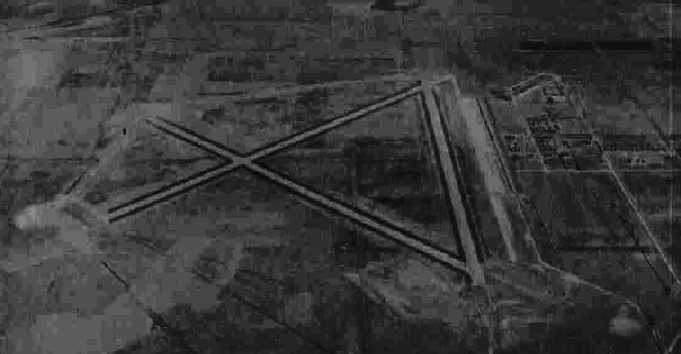
A 10/13/43 aerial view looking north at “Dalhart Army Air Field Auxiliary #2 (East Field)”
from the 1945 AAF Airfield Directory (courtesy of Scott Murdock).
This field was built during WW2 as one of 2 auxiliary fields for Dalhart AAF,
(a few miles to the southwest), which conducted training in B-17s, B-24s, B-29s & B-32s.
It was also known as Witt Field.
The date of construction of Dalhart Aux #2 has not been determined.
The earliest depiction which has been located of the field
was a 10/13/43 aerial view from the 1945 AAF Airfield Directory (courtesy of Scott Murdock).
It depicted “Dalhart Army Air Field Auxiliary #2 (East Field)”
as having 3 paved runways, with a large paved ramp on the east side
and a substantial number of buildings on a street grid to the east of the ramp.

As depicted on a 1943 Army plan (courtesy of John Voss),
Dalhart Aux AAF #2 consisted of 3 paved 8,000' runways,
taxiways & a large concrete ramp (measuring 205,000 square yards).
The 1945 AAF Airfield Directory (courtesy of Scott Murdock) described “Dalhart Army Air Field Auxiliary #2 (East Field)”
as an irregularly-shaped property within which were 3 bituminous 8,500' runways,
oriented north/south, northeast/southwest, and northwest/southeast.
The field was said to not have any hangars, and to be operated by the Army Air Forces.
However, the title of the listing described the field as Inactive.

The earliest aeronautical chart depiction which has been located of Dalhart Aux #2 was on the September 1945 Albuquerque Sectional Chart.
It depicted Dalhart #2 as an auxiliary airfield.
According to Matthew Byrd (who grew up adjacent to Dalhart AAF),
Auxiliary Field #2 was known as the East Base among locals.

"Dalhart AF #2" was still depicted as an active military airfield on the March 1950 Albuquerque Sectional Chart
It was described as having an 8,000' hard-surface runway.
Dalhart Aux #2 was apparently closed by the military at some point between 1950-63,
as it was labeled "Abandoned airport" on the March 1960 Albuquerque Sectional Chart
and the October 1963 World Aeronautical Chart (courtesy of Chris Kennedy).
Dalhart Aux #2 was no longer depicted at all on the February 1968 Albuquerque Sectional Chart.
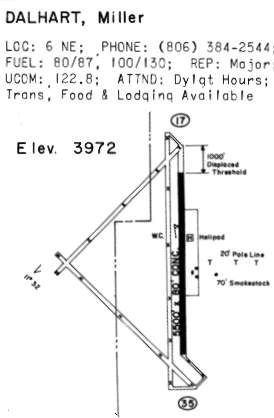
However, the former Dalhart Aux #2 field was apparently reopened as a civilian airport at some point between 1968-70,
as it was listed as Miller Field in the 1970 TX Airport Directory (courtesy of Ray Brindle).
It was named for Delmar Miller, a WW2-era instructor.
According to Matthew Byrd, Miller Field "used to be a hopping place in the 1960s & 1970s."

The 1973 USGS topo map depicted the former Dalhart Aux #2 ramp as “Miller Airfield”.
Three buildings were depicted to the east of the ramp, and 1 building was depicted on the ramp.
The former runways were no longer depicted at all.
In the 1985 TX Airport Directory (courtesy of Steve Cruse),
it can be seen that the runways of the former AAF were abandoned,
with the former ramp & a taxiway being reused as a 6,500' Runway 17/35.
The manager was listed as Delmar Miller.

In the 1996 USGS aerial photo, the remnants of the 3 former paved runways were still discernible,
although most of their pavement had been removed.
The paved ramp & taxiway on the east side of the field remained intact,
but there was no sign of any based aircraft.
The still-standing concrete sides were the only remaining portions of a hangar at Dalhart Aux #2 in 1998.
They were being used for storage.
As of 2002, the field was still in use as Miller Field, which supports infrequent crop-dusting operations.
It was described as being nearly deserted by general aviation pilots who have visited,
although the FAA Airport/Facility Directory listed a total of 4 aircraft as being based at the field.
Miller Field was evidently abandoned (for reasons unknown) at some point between 2002-2006,
as it was no longer listed in the FAA Airport/Facility Directory as of 2006 (according to Chris Kennedy).
Mike Brown reported from a 10/15/11 overflight, “I saw Dalhart #2, but I didn’t realize [at the time] it was what’s left of a WWII bomber field.
All you can see is the ramp, and it looks like an incredibly wide but not very long runway.”
Michael Dennis reported on 7/27/13, “Dalhart Aux #2: I wandered into this site when I saw the airport sign.
There are 2 cropdusters & what looked like a Cessna 172.
They were all more or less in a open hangar & no one [was] around.
Apparently the hangar was of postwar construction.
There was an office that looked like a Unicom office but open to the environment.
Judging from the interior ....probably early 1970s. Definitely not being used as a regular airport.”

A 2013 aerial photo showed the remnants of Dalhart Aux AAF #2's three former paved runways were still discernible,
although most of their pavement had been removed (except oddly for the very ends of most of the runways).
The paved ramp & taxiway on the east side of the field remained intact.
____________________________________________________
Pampa Army Airfield, Pampa, TX
35.53, -100.76 (Northeast of Amarillo, TX)

A 1942 U.S. Army facility area map of Pampa AAF.
This site was a pre-WW2 airfield which was taken over in 1942 by the AAF
as part of the 70,000 Pilot Training Program.
It was used by the Army Air Corps as a twin-engine flying school,
offering advanced twin-engine training in AT-10s.
Also stationed at the field were AT-9s, B-25s, and AT-17s.
The military airfield site encompassed 2,545 acres.
It was also known as the "Eagles' Nest of the High Plains".
The earliest depiction which has been located of Pampa AAF was a 1942 U.S. Army facility area map.
It depicted Pampa as having 4 paved runways,
with a large paved ramp on the west side,
and a “Administrative & housing area” street grid to the west of the ramp.
Calvin Casteel recalled, “I did Advanced Flight Training in AT-9, AT-10, and AT-17s at Pampa Army Air Field,
graduating in February 16, 1943.”
Improvements to the site included four 3,500' runways, a large paved ramp area, hangars,
a street grid with numerous buildings, water wells & a tower, a sewage disposal plant,
and ordnance areas & a skeet range.
A 5/15/43 AAF list of airfields of the Gulf Coast Training Center (courtesy of Ron Plante)
described Pampa Field as having 4 asphalt runways, with the longest being the 6,540' northeast/southwest & northwest/southeast strips.
It listed Pampa as having a total of 6 satellite fields:
Reeves Aux #1 (6 miles south of Pampa, TX),
Thompson Aux #2 (6 miles NNW of Pampa, TX), later reused as Perry Lefors Airport,
Hoover Aux #3 (9 miles northwest of Pampa AAF), of which no trace remains,
Laketon Aux #4 (9 miles ENE of Pampa AAF), of which no trace remains,
Jericho, and Pampa CAA.

The earliest photo which has been located of Pampa AAF
was a 10/13/43 aerial view looking north from the 1945 AAF Airfield Directory (courtesy of Scott Murdock).
It depicted Pampa as having 4 paved runways, with a large ramp on the west side,
with a large number of buildings west of the ramp.

A circa-1943 postcard from Pampa Field (courtesy of Steve Cruse).

An undated cover of a Pampa Army Air Field book.

An AT-17 trainer being prepared for a night flight inside a Pampa hangar during WW2.
Pampa AAF & its satellite fields, as depicted on the 1945 Oklahoma City Sectional Chart (courtesy of John Voss).
During its 3 years of operation the base graduated 6,292 cadets.
Pampa AAF was closed in 1945.
The 1945 AAF Airfield Directory (courtesy of Scott Murdock) described Pampa AAF
as a 2,544 acre square-shaped property within which were 4 bituminous runways,
the longest being the 6,540' northeast/southwest & northwest/southeast strips.
The field was said to have a total of 5 wooden hangars, the largest being a 202' x 163' structure.
Pampa was said to be owned by the U.S. Government, and operated by the Army Air Forces,
and to have 2 auxiliary fields (Reeves #1 & Thompson #2).
The other 4 auxiliary fields were evidently abandoned before 1945.
However, the title of Pampa AAF's listing described the field as Inactive.

A 1946 “Key Plan” (National Archives, courtesy of Ron Plante) depicted Pampa Army Airfield
as having 4 paved runways, taxiways, a large ramp, a street grid in a housing area, and an ordnance area to the north.
Pampa AAF was transferred as surplus to the Corps of Engineers in 1947.
It was then acquired by the Air Force in 1948 & redesignated Pampa AF Auxiliary Field #1.
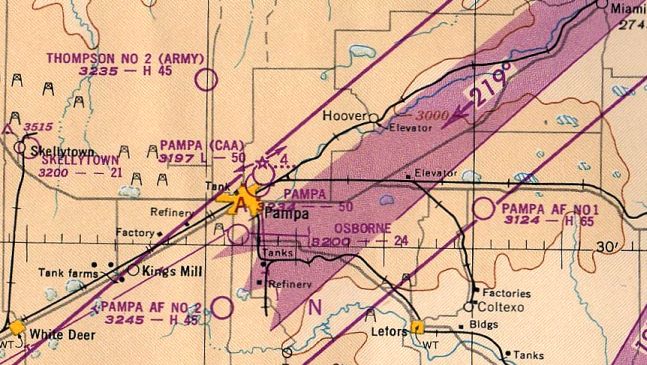
It was depicted as "Pampa AF #1" on the 1949 Oklahoma City Sectional Chart (courtesy of John Price).
The Pampa airfield remained on the Air Force property rolls until at least 1952, but was then closed again,
and the property was declared excess in 1955.

The last depiction which has been located of the Pampa airfield was on the 1956 USGS topo map,
which labeled the field as "Pampa AF #1".
The last tract of land of the Pampa airfield was sold in 1957.
Calvin Casteel recalled, “I visited what was remaining of Pampa Army Air Field in 1963 -
all that remained was a couple of hangars & part of the ramp which was being used as a cattle feed lot.”
The Pampa airfield was no longer depicted at all on the 1965 topo map
nor on the 1978 DFW Sectional Chart (courtesy of Ray Brindle).

In 1982 a Texas Historical Commission historical marker was placed near the site,
at the intersection of Rt.152 & Farm Road 3302.

As seen in the 1996 USGS aerial photo,
the only remaining elements of the former airfield were portions of the paved ramp area,
at least one hangar & several other buildings, and portions of the street grid.
All of the runways had been removed, with their location reverted to farmland.
The outline of the northeast/southwest runway was still barely discernible in the farmland.

Recent photo of the remains of the Pampa ramp.

Recent photo of a remaining hangar at Pampa.
Scott Murdock visited the site of Pampa AAF in 2003,
and reported that "Most of the airfield is fenced off & used for farming.
The runway patterns are faintly visible in aerial photos, but the ground is now farmland.
The most obvious remnant of AAF use is the concrete water tower."

A 2003 Army Corps of Engineers diagram of the WW2-era property boundaries of Pampa AAF.
The airfield at Pampa was not depicted at all (even as abandoned) on recent aeronautical charts or topo maps.

A 4/1/08 aerial photo showed Pampa's ramp & streets remained intact.
A faint outline of the northeast/southwest runway was still barely recognizable in the farmland.
The remnants of Pampa AAF are located southeast of the intersection of Route 152 & Ranch Road 1474.
See also:
A historical description from the Handbook of Texas Online.
A 1996 Army Corps of Engineers Project Fact Sheet.
A 1994 Army Corps of Engineers Ordnance & Explosives report.
____________________________________________________
Reeves Auxiliary Army Airfield #1 / Pampa Air Force Auxiliary Airfield #2, Pampa, TX
35.45 North / 100.98 West (Northeast of Amarillo, TX)

A 10/13/43 aerial view looking north at “Pampa Army Air Field Auxiliary #1 (Reeves Field)”
from the 1945 AAF Airfield Directory (courtesy of Scott Murdock).
This field was built during WW2 as one of 4 satellite fields for Pampa AAF (13 miles northeast),
which conducted advanced twin-engine training in AT-10s, AT-9s, B-25s, and AT-17s.
The dates of construction of Pampa Auxiliary #1 has not been determined,
but the parent field became operational in 1942.
A 5/15/43 AAF list of airfields of the Gulf Coast Training Center (courtesy of Ron Plante)
described Pampa Auxiliary #1 as having 3 asphalt 4,500' runways.
The earliest depiction which has been located of Pampa Aux #1
was a 10/13/43 aerial view from the 1945 AAF Airfield Directory (courtesy of Scott Murdock).
It depicted the field as consisting of 3 paved runways in a triangular layout.
No buildings or other improvements were visible.
The earliest aeronautical chart depiction which has been located of Reeves Aux #1
was on the 1945 Oklahoma City Sectional Chart (courtesy of John Voss),
which depicted Reeves #1 along with Pampa AAF & its other satellite fields.
The 1945 AAF Airfield Directory (courtesy of Scott Murdock) described “Pampa Army Air Field Auxiliary #1 (Reeves Field)”
as a 640 acre square-shaped property within which were 3 bituminous 4,500' runways,
oriented north/south, northeast/southwest, and northwest/southeast.
The field was said to not have any hangars,
to be owned by the U.S. Government, and operated by the Army Air Forces.
However, the title of the listing described the field as Inactive.

The last depiction which has been located of this airfield was on the 1949 Oklahoma City Sectional Chart (courtesy of John Price),
which confusingly labeled it as “Pampa AF #2".
Reeves Auxiliary #1 stayed on the books until at least 1952.
By 1978, it was no longer depicted at all (not even as an abandoned airfield)
on the DFW Sectional Chart (courtesy of Ray Brindle).

Two 1994 views of the site of Reeves Aux #1.
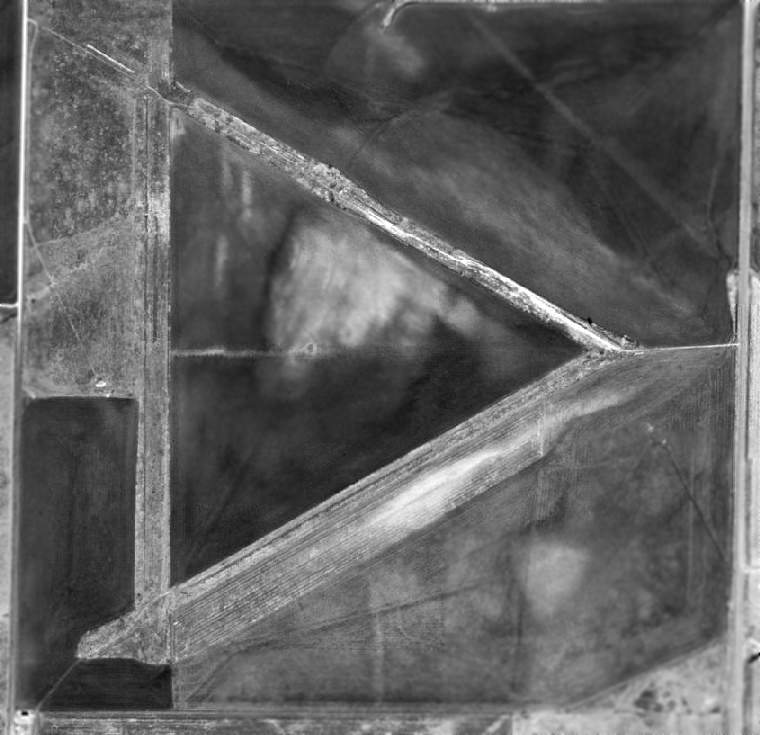
As seen in the 1996 USGS aerial photo,
the airfield consisted of three 4,200' runways,
which have deteriorated greatly but were still plainly discernible.
There did not appear to have been any hangars at the field.
Scott Murdock visited the site of Reeves Auxiliary #1 in 2003,
and reported that "The airfield is now farmed.
Aerial photos still show the runway patterns, though I could not discern them from ground level."
The airfield was no longer depicted at all (even as abandoned) on recent aeronautical charts or USGS topo maps.
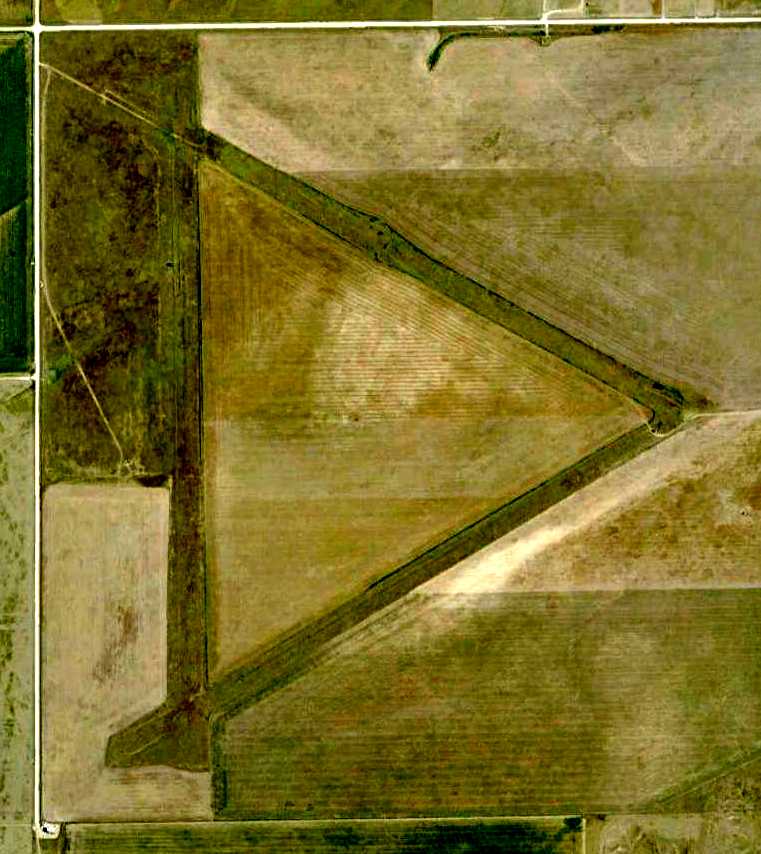
A 4/1/08 aerial photo showed the 3 runways remained quite recognizable.
The site of Reeves Auxiliary #1 airfield is located along the west side of Route 70, 6 miles south of the town of Pampa.
See also:
A 1996 Army Corps of Engineers Project Fact Sheet.
A 1994 Army Corps of Engineers Ordnance & Explosives report.
____________________________________________________
Since this site was first put on the web in 1999, its popularity has grown tremendously.
That has caused it to often exceed bandwidth limitations
set by the company which I pay to host it on the web.
If the total quantity of material on this site is to continue to grow,
it will require ever-increasing funding to pay its expenses.
Therefore, I request financial contributions from site visitors,
to help defray the increasing costs of the site
and ensure that it continues to be available & to grow.
What would you pay for a good aviation magazine, or a good aviation book?
Please consider a donation of an equivalent amount, at the least.
This site is not supported by commercial advertising –
it is purely supported by donations.
If you enjoy the site, and would like to make a financial contribution,
you
may use a credit card via
![]() ,
using one of 2 methods:
,
using one of 2 methods:
To make a one-time donation of an amount of your choice:
Or you can sign up for a $10 monthly subscription to help support the site on an ongoing basis:
Or if you prefer to contact me directly concerning a contribution (for a mailing address to send a check),
please contact me at: paulandterryfreeman@gmail.com
If you enjoy this web site, please support it with a financial contribution.
please contact me at: paulandterryfreeman@gmail.com
If you enjoy this web site, please support it with a financial contribution.
____________________________________________________
This site covers airfields in all 50 states.